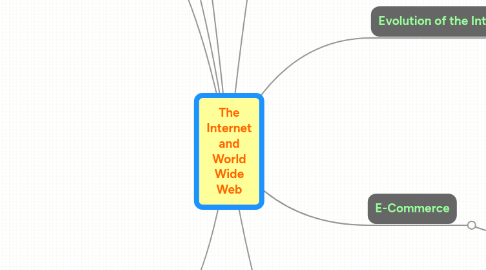The Internet and World Wide Web
por Wichuda Sakwikrom


1. The Internet
1.1. The internet is a woldwide collection of networks that links millons of business, goverment agencies, educational institutions, and individuals
1.1.1. New node
2. The World Wide Web
2.1. The World Wide Web, or web,consists of a worldwide collection of electronic documents (Web pages)
2.2. A Web site is a collection of related Web pages and associated items
2.3. A Web server is a computer that delivers requested Web pages to your computer
2.4. Web 2.0 refers to Web sites that provide a means for users to internet
2.5. A Web browser, or browser, allows users to access Web pages and 2.0 programs
2.6. A Web page has a unique address called a URL or Web address
2.7. Tabbed browsing allows you to open and view multiple Web pages in a single Web browser window
2.8. Two types of search tools are search engines and subject directories
2.9. A search engine is helpful in locating items such as
2.10. Some Web browser contain an Instant Search box to eliminate the steps of displaying the search engine's Web page prior to entering the search text
2.11. Search operators can help to your search
2.12. There are thirteen types of Web sites
2.13. Multimedia refers to any application that combines text with:
2.14. A graphic is a digital representation of nontext information
2.15. A thumnail is a small version of a lager graphic
2.16. Animation is the appearance of motion created by displaying a series of still images in sequence
2.17. Video consists of full-motion images that are played back at various speeds
2.18. A plug-in is a progarm that extends the capabillity of a Web browser
2.19. Web publishing is the development and maintenance of Web pages
3. Netiquette
3.1. Netiquette is the code of acceptable internet behavior
4. Summary
4.1. History and stucture of the internet
4.2. World Wide Web
4.3. Browsing,navigating,searhing,Web publishing,and e-commerce
4.4. Other internet services e-mail instant messaging, chat rooms,VoIP,newsgroups and message boards, and FTP
4.5. Rules of netiquette
5. Objectives Overview
5.1. Discuss the evolution of the Internet
5.2. Indentify and briefly describe various broadband internet connections and state differences between broadband internet connections and dialup connections
5.3. Describe the tyeps of internet access providers
5.4. Describe the purpose of an IP address and its relationship to domain name
5.5. Explain the purpose of a Web browser and identifly the complain of a Web address
5.6. Descibe how to use a search engine to for information on the Web and differentate between a search engine and a subject directory
5.7. Describe the types of Websites
5.8. Explain how Web pages use graphics, animation, audio, video, virtual reality, and plug-ins
5.9. Identifly and briefly describe the steps required for Web publishing
5.10. Describe the types of ecommerce
5.11. Explain how e-mail, mailing lists, instant messaging chat rooms, VoIP, newsgroups and message boards, and FTP work
5.12. Identifly the rules of netiquette
6. Evolution of the Internet
6.1. The internet originals as ARPANET in September 1969 and had two main golas
6.2. Each organization is reponsible only for maintaining its own network
6.3. Inyernet2 connects more than 200 universities and 115 companies via a high-speed private network
6.4. Many home and small business users connect to the internet via high-speed boradband internet service
6.5. An access provider is a business that invidials and organizations access to the Internet free or for a free
6.6. An IP address is a number that uniquely identifies each computer or device connected to the interner
6.7. A domain name is the text version of an IP address Top-level domain(TLD)
6.8. A DNS server translates the domain name into its associated IP address
7. E-Commerce
7.1. E-commerce is a business transaction that occurs over an electronic network
7.1.1. M-commerce identiflies e-commerce that takes places using mobile devices
8. Other Internet Services
8.1. Instant messsaging (IM) is a real-time internet communications service
8.2. A chat is a real-time typed conversation that takes place on a computer
8.3. A chat room is a location on an internet server that permits users to chat with each other
8.4. E-mail is the transmission of messages and files via a computer network
8.5. An e-mail program allows you to create, send,receive,forword,store,print,and delete e-mail messages
8.6. VoIP(Voice over IP) enables users to speak to other users over the internet
8.7. A newsgroup is an online area in which users have written discussions about a particular subject
8.7.1. Typically requires a newsreader
